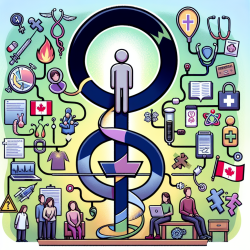Introduction
In the ever-evolving landscape of healthcare, the need for precise and safe prescribing practices is paramount, especially when it involves opioids. The research article "Toward Safer Opioid Prescribing in HIV care (TOWER): a mixed-methods, cluster-randomized trial" provides a comprehensive framework for enhancing opioid prescribing practices in HIV care settings. This blog post will delve into the outcomes of this research and how practitioners can leverage these findings to improve their skills and patient outcomes.
Understanding the TOWER Intervention
The TOWER intervention was developed to implement the CDC's opioid prescribing guidelines within HIV-focused primary care settings. It was designed using a multi-step iterative process grounded in the Information, Motivation, and Behavioral Skills (IMB) framework. The intervention includes three key components:
- A patient-facing opioid management app (OM-App)
- A progress note template (OM-Note) to guide office visits
- Primary care provider (PCP) training
These components aim to enhance adherence to CDC guidelines by providing tools and training that facilitate better documentation and decision-making processes.
Key Findings and Their Implications
The TOWER trial demonstrated significant improvements in CDC guideline adherence among PCPs who utilized the intervention. Key areas of improvement included the use of non-pharmacologic treatments, setting functional treatment goals, and the implementation of opioid agreements. Importantly, these improvements were achieved without any intervention-associated safety concerns, such as worsening patient-reported outcomes.
For practitioners, these findings highlight the importance of structured interventions in promoting guideline adherence. By integrating tools like the OM-App and OM-Note into their practice, healthcare providers can ensure more consistent and comprehensive care for patients on long-term opioid therapy.
Encouraging Further Research and Implementation
While the TOWER intervention shows promise, further research is needed to explore its scalability and impact on public health outcomes. Practitioners are encouraged to engage with ongoing research efforts and consider participating in trials that aim to refine and expand upon these findings.
Additionally, practitioners should consider how they can incorporate similar data-driven approaches into their own practice settings. This might involve collaborating with researchers to develop tailored interventions that address specific needs within their patient populations.
Conclusion
The TOWER intervention offers a valuable framework for improving opioid prescribing practices in HIV care. By focusing on guideline adherence and leveraging technology to support decision-making, practitioners can enhance patient safety and outcomes. As we continue to navigate the complexities of opioid prescribing, data-driven strategies like TOWER will be essential in shaping the future of healthcare delivery.
To read the original research paper, please follow this link: Toward Safer Opioid Prescribing in HIV care (TOWER): a mixed-methods, cluster-randomized trial.










